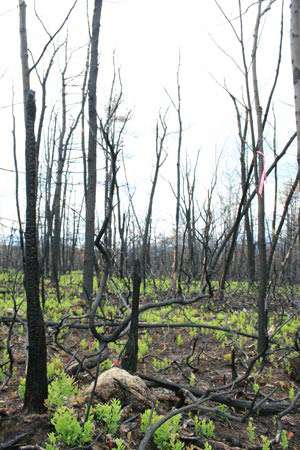
When it comes to fires, forest management practices across the U.S. have evolved considerably in recent decades, from complete fire suppression in all forests to the realization that fire plays an important role in many ecosystems. A recent study examining the impact on biodiversity of fires of varying intensity levels may lead to the next step in this evolution.
Ithaca College biology professor John Confer surveyed for nesting birds soon after a 3,000-acre fire burned for three days in Minnewaska State Park in New York. The fire, probably lit by a discarded cigarette, started in late March along a highway and burned through an oak forest with scattered pitch pines and a heavy understory of mountain laurel, blueberry, and other shrubs. In areas that Confer described as “severe burn,” virtually 100 percent of the above-ground growth was killed, though two months after the fire, new stems had begun to grow from oak roots and trunks. In “light burn” areas, where the fire did not reach, or only singed the canopy, all of the trees survived and most trees in the understory were producing new leaves.
Confer expected to find a lower density of birds in the burned areas than in an unburned control area nearby, and he did, but the numbers of both individuals and species were considerably higher than he had anticipated. And when he compared the birds found on the two burned areas with the control area, he was surprised to find five species of birds in the severe-burn area that were absent in both the light-burn and control areas. Most of these
species were those known to prefer open habitat or feed
on the ground, including eastern bluebird and mourning dove.
“If you’re looking at a large landscape and you don’t care that for a couple years it’s going to look black, then a severe burn creates habitat diversity and increased species diversity,” Confer said. “Just like with the Yellowstone fire, following severe burns you get habitat diversity and avian diversity.”
Confer noted that most species of forest-breeding birds in the eastern United States are increasing in population, while almost all species that prefer what he called “disturbance ecosystems” are decreasing. “If we want to manage for biodiversity, then severe fires in a few appropriate locations would be the way to enhance diversity.”
According to Confer, the standard ecosystem management practice is frequent, controlled, light fires to reduce forest debris and reduce the intensity of an unplanned fire. But his results suggest that this practice does not necessarily benefit biodiversity. And while he recognizes that the great fear in the case of severe fires, especially crown fires, is that they are not controllable, he is an advocate of severe fires of 3,000 acres or so once every 30 years in large, fire-prone forest lands.
“It’s not the prevailing perspective, but that’s what I would do,” he said. “There’s no doubt that biodiversity is enhanced where you have an occasional severe fire.”

